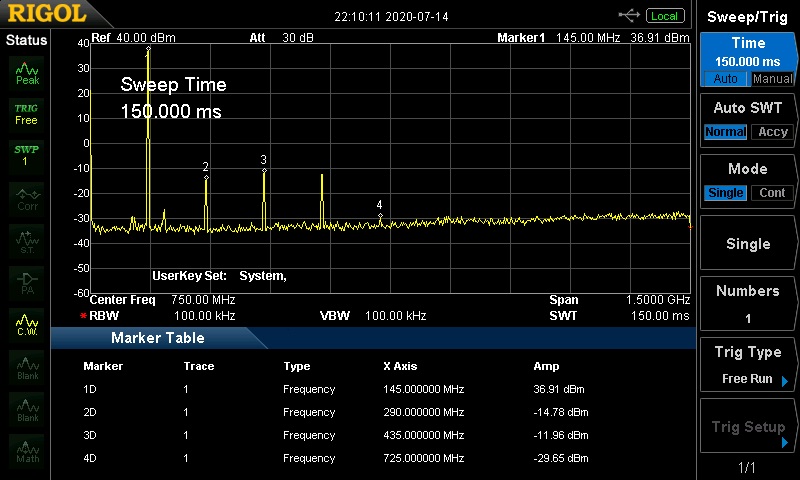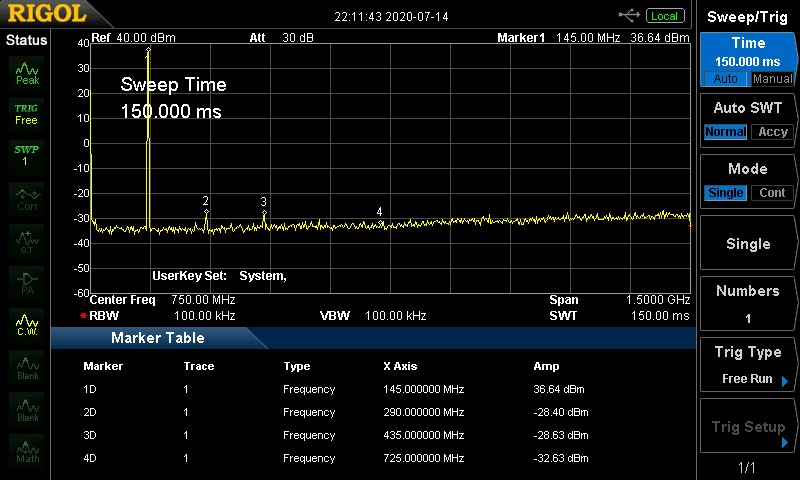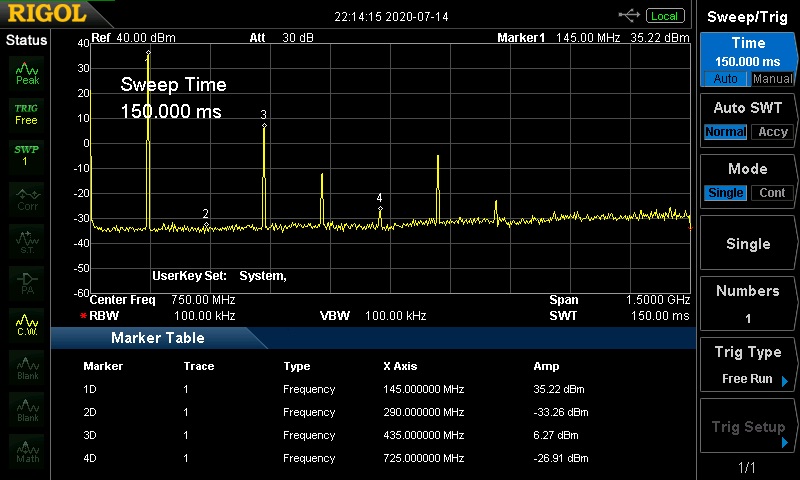They’re not. The problem is a receiver design issue. That is what the linked article discusses. There’s a link to a table of handhelds ranking them in order of performance for this kind of problem.
Always look at the specs… the best hand-helds have double conversion superhet receivers. Any single conversion (inexpensive) model will be terrible on receive… Yes, cheap HT’s work, and I hate to offend the Baofeng crowd (I still have 2 Baofengs myself,) but double conversion wins hands down. Beware that all the big three have single conversion in their less expensive models also, but remember you’re paying the higher price for the better receiver when you get the double conversion model.
Oh dear. All that development work on SDRs has been wasted.
SDR 2 meter HT? Maybe I have missed a product that offers this. Original poster is looking for a “hand-held” that is less susceptible to intermod/overload."
I think amateurs need to remind themselves of what the dial frequency on a radio actually means, and what it does not mean.
It only means the local oscillator is on a frequency that when mixed with the desired signal will produce a signal on the intermediate frequency of the receiver. That’s all it means. (For heterodyne receivers).
For SDRs sampling at 144 mhz, it still only means that the signals on the dial frequency are the ones that will be demodulated correctly.
It does not mean there is any tuned circuit on the desired frequency capable of rejecting all other signals. Often there is only a simple bandpass filter to pass the entire VHF spectrum, or more. It prevents interference by GPS satellites, UHF TV and MF broadcast stations, but not much more.
This is why a high quality bandpass filter between the antenna and radio is so beneficial. It was left out of the cheap HT, so to make that work correctly, you need to add the filter.
Andrew VK1DA/VK2UH
The really cheap HTs like Baofeng use the SDR chip as a receiver. Put a strong transmitter nearby, and an SDR becomes deaf.
I mentioned that I use the Icom IC-2A and IC-2AT HTs for SOTA because of their superior rejection of signals away from the frequency on the dial. I work in broadcasting and spend a lot of time at transmitter sites. The Icom IC-2AT (and the Radio Shack HTX-202) are the only HTs that still work perfectly at my most densely populated sites. I’m sure there are other HTs that would work also, but even my VX-2, VX-6, and others don’t. Adding a bandpass filter certainly helps, but it becomes cumbersome compared to just using an HT that doesn’t get overloaded by high power VHF transmitters nearby.
Richard’s point, I’m sure, is that well designed SDRs, single conversion and double conversion radios will all work well, and dismissing any of them on the basis of known poor implementations could potentially eliminate a good (or better) design from your consideration simply due to absolutes.
What Richard failed to realise is this is a ham radio forum. There is no place for shades of grey, even where shades exist.

There is not an SDR chip made yet that has the kind of adjacent channel rejection that a double or triple conversion monoband 2m HT does. So, he was correct.
The SDR chip receivers are horrible at rejecting strong out of band signals simply due to physics. People seem to assume that newer equals better, but it does not. Especially in this case.
It is necessary to distinguish between adjacent channel selectivity and problems caused by front end overload. Selectivity issues may mean you hear bits of the next channel as well as the signal you are listening for. But overload means your receiver goes deaf, possibly makes strange noises, but generally gives no outward indication that something is flattening it.
It is the overload problem that is the silent “killer” of many modern VHF radios because they do not have the necessary filtering in the front end.
I’m seeing a confusion between a software-defined receiver (where receive filtering and demodulaton is in software) and a direct sampling receiver (with an A/D at the receive frequency). An SDR can be a superhet (Elecraft K3), direct conversion (KX2 and KX3), or direct sampling (the upcoming K4).
The cheap HTs use the RDA1846 single-chip transceiver (or similar). That is a direct conversion SDR design. The local oscillator is at the receive frequency and converts the desired signal to baseband. At baseband, it has A/D converters for I/Q.
The chip has no filtering on receive, so it is vulnerable to overload. It also doesn’t filter for transmit, so the spurious emissions on 2 m make it illegal for amateur use in the US. The Yaesu FT-4XR/E uuses the same chip but adds filtering, so it is legal on transmit and probably better protected on receive than the average Baofeng.
RDA1846 data sheet: https://www.w5txr.net/upload/RDA%20%20Microelectronics%20RDA1846.pdf
Baofeng teardown: https://www.allaboutcircuits.com/news/teardown-tuesday-baofeng-amateur-radio-transceiver/
My blog post about Baofeng spurious emissions: BaoFeng HTs and Spurious Emissons | Most Casual Observer
wunder
Excellent post on clarifying different implementations of SDR.
One comment though, the Baofeng UV-5R & family actually have a reasonable amount of filtering on both receive and transmit; it can even be seen in the teardown link you yourself linked.
By “reasonable” I mean it’s close to the legal requirements even if a large part of the units don’t actually meet them by a few microWatts. Those filters are designed to be first of all cost effective (generic capacitors, etc) and they certainly could use improvement, but they’re far from “no filtering”. Strongest harmonic is -49dBc.
The FT-4X is a slightly better implementation of the RDA1846, more attention has been paid to frontend filtering (on both radios filtering is largely shared between RX and TX) and it surpasses emissions requirements easily. RX is a bit less sensitive to adjacent channel intermod but it’s still in the same class as the Baofeng for all SOTA intents and purposes due to the weak RDA1846 radio. Strongest harmonic -65dBc.
For reference, here is how the harmonics of a “no filtering” radio look. This radio is popular and has been out there for a few years already, yet no one complained so far. I won’t say what it is yet as it’s a review sample and I’m still waiting to hear back from the manufacturer. Strongest harmonic -29dBc.
Thanks for the spectrum analyzer shots. Those make the difference clear.
AD5GG points out that the UV-5R meets FCC Part 90 (business) emission requirements but not Part 97 (amateur).
In the ARRL Lab tests at hamfests, less than 10% of Baofengs met the Part 97 standards. I would explain that with normal component variation. There are a few “good ones”.
In practical use, I agree that a few microwatts might not be a problem. I expect the Part 97 regs were concerned with kilowatt transmitters, though that does not change what they say.
For SOTA, I’m less concerned about adjacent channel interference than about out of band overload. This Friday, I plan to hike up San Bruno Mountain, home to quite a few transmitters. The road to the top is “Radio Road”. Maybe I’ll bring my Baofeng, too.
wunder
I have a summit 30 minutes from the QTH that is (in)famous for overloading the front end of HTs. I’ve had the best luck on VHF with a Yaesu FT-270, followed closely by an FT-60. Both are a Double Conversion Superheterodyne design. You’d be hard pressed to find anything that would work better.
I’ve tried a Baofeng and Radioddity on the same summit and was completely deaf. A friend’s Kenwood also had issues, although performed much better then the two aforementioned radios. An FT818 also worked pretty well on 2m SSB.
Icom IC-2AT or Radio Shack HTX-202 will.
But they aren’t available anymore. ![]() Only the FT60 is still a current model.
Only the FT60 is still a current model.
No, but they are plentiful and affordable on the used market.
As a follow up to my original post: I managed to find an ICOM IC-V80 handheld, little used, for a very good price. It ranks highly for 3rd order dynamic range on the list provided above ( VHF/UHF handheld performance comparison | QRPblog)
I have tested it at a few summits that have strong RF fields from commercial installations nearby and I have yet to experience any intermod/rx overload, so I am very happy with it. It is also built like a tank so that is also reassuring.
Larry.
I have the V86 which only once had a small amount of interference from nearby equipment. Same summit Ken’s (VE6AGR) FT3DR was swamped. I think you will find the V80 to be a solid radio.
Malen
VE6VID
Ha! As a young ham over 3 (almost 4) decades ago I declared “I’ll never get rid of my IC-2AT!”
I still have it - simple, works great, IMD free! (I did buy the AA alkaline pack to keep it going.)
Also - no menus  No memory, no scan, no channels… Just dial in your freq, set your repeater offset +/- (or simplex) - and you’re talking. I love the simplicity!!
No memory, no scan, no channels… Just dial in your freq, set your repeater offset +/- (or simplex) - and you’re talking. I love the simplicity!!
VE6VID,
Are you still liking your V86 for SOTA? I am considering picking one up due to the better front end, higher power and large battery. But I don’t know if it would be worth saving up a bit more and getting a double super-het HT like the 70DR. Though, I’ve heard the 70DR has terrible battery life.


